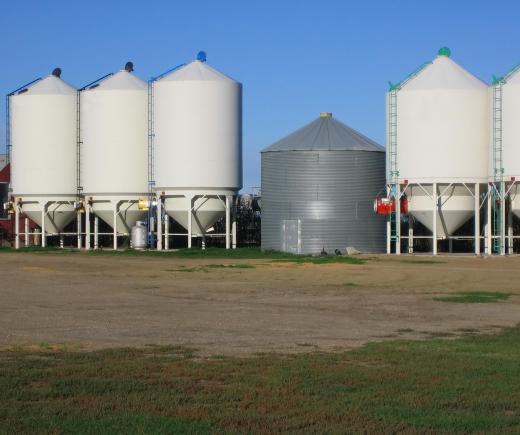A bulk tank is a specially manufactured tank that can be used to store a variety of goods, including liquids, gases, chemicals, powders, grains, construction materials and minerals. The tanks are produced in a wide array of sizes, shapes and types. Examples of bulk tanks include mobile trailers hauled by tractor-trailer vehicles, stilt-supported tanks raised above ground level, tanks that rest upon the ground and subterranean tanks. Some bulk tanks are used to transport materials with special internal pressure or temperature requirements. These tanks often use special equipment to maintain a stable internal environment.
A bulk tank provides safe storage for solids, liquids, gases and a variety of compounds and mixtures, as well as protection from any hazardous materials. The amount that a bulk tank can hold varies with the type. Typically, bulk tanks of any sort are used to store or transport large amounts of any given material. Bulk tanks can be constructed for whatever volume is required, whether small enough for a tractor-trailer or large enough for a storage silo.

A liquid bulk tank, like those used for milk storage and cooling, are constructed of a minimum of two layers of stainless steel. Polyurethane foam usually forms an insulating layer between the outer tank and the inner wall. Milk tanks are equipped with systems to maintain a steady temperature and keep the stored liquid fresh. Most of these tanks also possess various fittings to allow liquid to be added or removed, a small manhole cover to view the contents or grant manual access to internal fittings and an internal cleaning system to maintain required health and safety standards.

Other containers — including those used to store fluids such as liquefied petroleum gas or gases such as helium and nitrogen — might possess additional controls to maintain uniform pressure throughout the bulk tank. The storage and transportation of fuel often requires a set pressure to maintain fuel effectiveness, and fuel must be kept at a certain temperature for safe handling. Liquid storage tanks might be modified for use with transport vehicles, portable units, ground containers or stilt-supported containers such as water towers.

Bulk cement tanks are often used in construction. These tanks store various dry goods, such as cement, grain, sand and more. Some versions of dry bulk tanks include an internal screw pump, which allows stored materials to be mixed prior to release. This ensures that if the contents settle or separate over a long stationary period, they do not need to be remixed upon being released.
